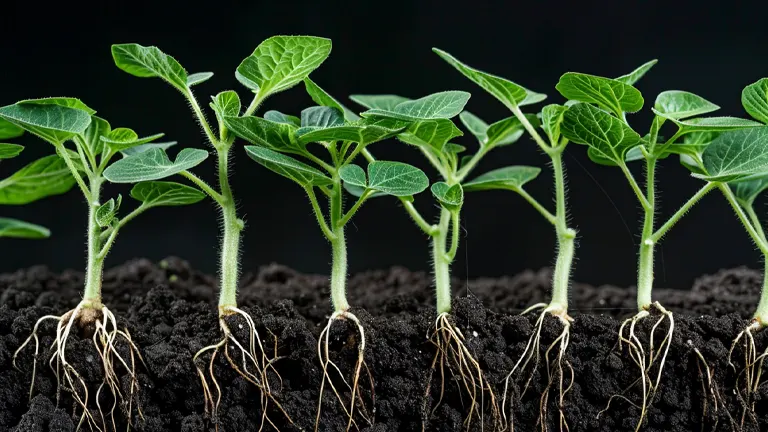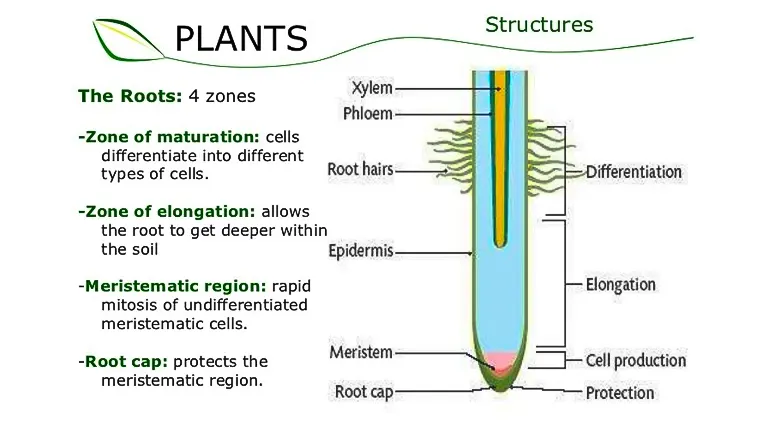What is a Root Zone? The Secret Behind Your Garden’s Success
- June 13, 2024
- 0 comment
What is a Root Zone? Discover how this crucial layer impacts your garden’s health and success, and master the secrets of thriving plants. Have you ever noticed how some gardens just seem to burst with life, while others barely hang on? The secret might just be hidden beneath the soil—in the root zone.

This essential area is a game-changer for your plants, managing nutrients and water like a natural control center. Let’s explore what a root zone is and how you can leverage its power to boost your garden’s health and beauty. Ready to get your hands dirty and your plants thriving? Here we go!
Table of Contents
- Defining the Root Zone
- Components of the Root Zone
- The Science Behind Root Zone Management
- Enhancing the Root Zone
- Practical Tips for Root Zone Care
- Common Root Zone Problems and Solutions
- The Role of Organic Matter in the Root Zone
- Innovative Root Zone Technologies
- Impact of Climate on the Root Zone
- Advanced Techniques in Root Zone Optimization
- Conclusion
- FAQs
Defining the Root Zone
What is the Root Zone?

The root zone, also known as the rhizosphere, encompasses the soil environment immediately surrounding plant roots. This zone is a dynamic interface where numerous biological and chemical processes occur, significantly impacting plant health and growth. Here, intricate interactions among roots, soil organisms, nutrients, and environmental factors play a critical role in a plant’s life cycle, influencing everything from nutrient uptake to disease resistance.
Root System: Root architecture varies widely among plant species and is intricately adapted to their environmental conditions. Root systems can be categorized primarily into two types:
- Taproots: These roots penetrate deeply and are excellent for accessing water from lower soil layers. They are typical in plants like carrots and dandelions.
- Fibrous Roots: These spread out shallowly but extensively near the soil surface, enhancing nutrient uptake from the topsoil. Grasses and many annual plants exhibit this root type.
Both root types have adaptations that optimize their survival and efficiency in specific environments, influencing how gardeners should approach root zone management.
Components of the Root Zone
Soil Texture and Structure

Soil texture is a critical factor in determining the health and functionality of the root zone. The size of soil particles and their composition significantly affect how soil behaves under various environmental conditions:
- Clay Soils: Composed of very fine particles, clay can retain nutrients and water efficiently. However, its density can hinder root growth and reduce aeration, leading to potential root suffocation if the soil becomes too compacted. Permeability in these soils can be as low as 0.1 mm/hr, indicating slow drainage.
- Sandy Soils: With coarse particles, sandy soils ensure excellent drainage and aeration, which helps prevent root diseases associated with excess moisture. However, their inability to hold nutrients and water requires more frequent irrigation and fertilization, with permeability rates often exceeding 20 mm/hr.
- Loam Soils: An ideal blend of sand, silt, and clay, loam maintains a balance with a permeability rate ranging from 6 to 20 mm/hr. It offers sufficient drainage while retaining necessary moisture and nutrients, making it optimal for a wide variety of plants.
Characteristics of Soil Types in the Root Zone
| Soil Type | Particle Size | Water Retention | Nutrient Retention | Aeration | Permeability (mm/hr) |
|---|---|---|---|---|---|
| Clay | <0.002 mm | High | High | Low | 0.1-1 |
| Sand | 0.05-2 mm | Low | Low | High | 20-100 |
| Loam | Mixed | Medium | High | Medium | 6-20 |
Soil Organisms
The root zone is a vibrant ecosystem teeming with microbial life that plays a pivotal role in plant health. These microorganisms include:
- Beneficial Bacteria: These bacteria convert nutrients into forms readily absorbable by plants, and some fix atmospheric nitrogen into the soil.
- Fungi, including Mycorrhizae: Mycorrhizal fungi form symbiotic relationships with plant roots, extending significantly beyond the root system to increase the plant’s access to water and nutrients. The extent of this symbiotic network can increase nutrient absorption surface area by up to 1000 times.
Root Architecture
The configuration of a plant’s roots is highly adaptive and varies among species to optimize resource uptake:
- Taproots: Characteristic of plants like carrots and dandelions, these roots delve deep into the soil, accessing moisture and nutrients from deeper layers. This system is particularly advantageous in dry environments.
- Fibrous Roots: Many grasses and surface-feeding plants have fibrous root systems that spread horizontally close to the soil surface, maximizing nutrient absorption from the upper soil layers, which is crucial in nutrient-rich environments.
Understanding root architecture is essential for effective garden planning and plant selection, ensuring that each plant’s root system is compatible with the soil’s characteristics.
The Science Behind Root Zone Management
Nutrient Availability and Soil Chemistry
The root zone, or rhizosphere, serves as the principal channel for nutrient absorption in plants. In this dynamic environment, soil nutrients present in various chemical forms interact differently, influencing their availability to plants. Critical macronutrients such as nitrogen, phosphorus, and potassium each exhibit unique soil behaviors:
- Nitrogen, often found as nitrates, is highly soluble and prone to leaching, especially in sandy or heavily irrigated soils. To mitigate this, strategic application of nitrogen sources and the use of cover crops can enhance nitrogen retention.
- Phosphorus tends to bind tightly with soil particles, making it less available to plants. This binding capacity varies with soil pH; hence, adjusting pH can enhance phosphorus availability.
- Potassium, while less mobile than nitrogen, can still be lost through leaching in sandy soils or soils with low cation-exchange capacity.
Innovative soil management techniques, such as applying slow-release fertilizers or using mycorrhizal fungi, can optimize nutrient availability. Mycorrhizal fungi, for instance, extend the root system’s reach, effectively increasing nutrient uptake, particularly phosphorus.
Water Dynamics and Plant Hydration
Effective water management within the root zone is essential for maintaining plant health. The soil’s texture and structure significantly influence its water-holding capacity and drainage properties:
- Sandy soils are highly porous, offering excellent drainage but poor water retention. Frequent, light watering helps maintain an optimal moisture level without causing saturation.
- Clay soils, in contrast, retain water effectively but can impede drainage, potentially leading to waterlogging. Infrequent but deep watering encourages deeper root growth and prevents surface water accumulation.
Incorporating organic matter such as compost or coir can improve the water retention of sandy soils and the aeration of clay soils, promoting healthier root development.
Aeration and Root Respiration
Oxygen is critical for root respiration, a process where roots consume oxygen to metabolize glucose into energy. Soil compaction can severely restrict oxygen flow, which stunts root and plant growth. Regular aeration, achieved by gentle tilling or the addition of organic matter, can prevent compaction and promote a healthy root environment. Organic materials like perlite or vermiculite can also be mixed into the soil to enhance porosity and oxygen availability.
Scientific Analysis and Data Table
To illustrate the effects of different soil management strategies on nutrient availability and root health, the following table presents data from a controlled study measuring nutrient levels and root growth under various soil conditions:
| Soil Type | Nitrogen Content (mg/kg) | Phosphorus Availability (%) | Potassium Levels (mg/kg) | Water Retention Capacity (%) | Root Growth Index |
|---|---|---|---|---|---|
| Sandy | 50 | 10 | 150 | 30 | 2.5 |
| Loam | 120 | 25 | 250 | 50 | 7.0 |
| Clay | 70 | 15 | 180 | 70 | 5.0 |
| Sandy + Compost | 80 | 20 | 190 | 45 | 6.5 |
| Clay + Perlite | 65 | 18 | 170 | 65 | 6.0 |
Key Findings:
- Adding compost to sandy soil significantly increases nitrogen and potassium levels while improving water retention and supporting more robust root growth.
- Introducing perlite into clay soils enhances aeration and slightly improves nutrient availability, reflecting in better root development metrics.
Enhancing the Root Zone
Advanced Soil Amendments

Amending the soil is a crucial strategy for enhancing the root zone’s capacity to support healthy plant growth. Organic materials, such as compost, peat, and well-rotted manure, not only improve soil structure but also enrich nutrient content and increase microbial activity, which in turn boosts nutrient availability to plants. For instance, the addition of compost can elevate soil organic matter content by up to 20%, enhancing both nutrient retention and water holding capacity.
In contrast, inorganic amendments like perlite and vermiculite serve primarily to improve soil aeration and drainage. This is particularly beneficial in dense clay soils where poor aeration can impede root growth. Adding these amendments can increase pore space by 15-30%, significantly enhancing oxygen availability to the root zone and facilitating healthier root development.
pH Management and Electrical Conductivity
Soil pH is a critical factor that directly affects nutrient solubility and availability. Most essential nutrients are optimally available to plants at a pH range of 6.0 to 7.0. Regular soil testing and subsequent adjustments of soil pH are vital for maintaining optimal plant health. Lime can be used to increase the pH of acidic soils, while sulfur is suitable for lowering the pH of alkaline soils. Proper pH adjustment can increase nutrient uptake efficiency by up to 50%.
Electrical Conductivity (EC) is another crucial parameter, reflecting the soil’s salt concentration. An ideal EC level suggests balanced nutrient availability, whereas high EC levels may indicate excessive fertilizer application, leading to potential root burn and reduced plant growth. Managing EC involves adjusting fertilizer applications and enhancing soil composition to regulate salt levels effectively.
Root Zone Heating: Enhancing Growth in Cold Climates
In cooler climates, maintaining an optimal root zone temperature is fundamental for extending the growing season and improving plant vigor. Root zone heating, such as using soil heating cables or heated propagation mats, can increase soil temperature by 5-10°C, which significantly promotes faster root development and vigorous early seedling growth. This technique ensures that plants can fully exploit the growing season, especially in regions with short warm periods.
Scientific Analysis and Data Table
To quantify the impact of these root zone enhancement techniques, the following table presents experimental data from a study comparing growth metrics across different soil amendment and heating setups:
| Treatment | Soil Organic Matter (%) | Water Retention Capacity (%) | Root Length (cm) | Plant Biomass (g) | EC (dS/m) |
|---|---|---|---|---|---|
| Control (Unamended Soil) | 2.0 | 25 | 10 | 50 | 0.5 |
| Organic Amendment (Compost) | 5.0 | 40 | 15 | 75 | 0.3 |
| Inorganic Amendment (Perlite) | 2.5 | 30 | 12 | 60 | 0.4 |
| pH Adjusted + Organic | 5.5 | 45 | 20 | 90 | 0.2 |
| Root Zone Heating | 2.0 | 25 | 25 | 100 | 0.5 |
Practical Tips for Root Zone Care
Mulching: Mulching is crucial for maintaining a healthy root zone. It helps retain soil moisture, regulates soil temperature, and reduces weed growth. Use organic materials such as straw, bark, or leaf litter as mulch. These not only protect the soil but also enhance its fertility as they decompose. Apply mulch around plants while avoiding direct contact with stems to prevent potential moisture-related diseases.
Irrigation Practices: Proper irrigation is vital for root zone health. Over-watering can lead to root suffocation and disease, while under-watering can stress plants. Drip irrigation systems are effective as they deliver water directly to the soil, minimizing evaporation and leaf wetness that can cause plant diseases. Watering plants in the early morning is also advisable, as it allows water to reach deeper into the soil, ensuring that roots are adequately hydrated.
Regular Monitoring: Monitoring the root zone regularly is essential for maintaining plant health. Use a soil probe or garden trowel to check soil moisture and examine the roots occasionally to assess their health. Look for changes in soil texture and moisture levels. Adjusting care practices based on these observations can help prevent issues from becoming severe.
Common Root Zone Problems and Solutions

Compaction: Soil compaction can dramatically decrease the air and water available to roots, leading to poor plant growth. Signs include water pooling on the surface and stunted growth. To address compaction, aerate your soil with a fork or a core aerator, which removes small plugs of soil to enhance aeration.
Root Rot: Root rot is typically caused by excessive soil moisture. Ensuring good drainage is crucial; incorporate coarse sand or organic matter into your soil to improve drainage. For gardens prone to waterlogging, consider using raised beds. If root rot occurs, indicated by discolored, mushy roots, remove the affected areas and adjust watering to allow the soil to dry properly.
Salinity Issues: High soil salinity can occur from over-fertilization, harming plant roots and reducing growth. To manage this, flush the soil with ample water periodically to wash away excess salts. Regular soil tests can help track salt levels, allowing for better management of fertilization and preventing excessive salt buildup.
The Role of Organic Matter in the Root Zone

Incorporating organic matter into the root zone significantly enhances the overall health of your garden. Adding materials like compost, leaf mold, or manure improves soil structure, making it more friable and easier for roots to penetrate. This adjustment also enhances water retention capabilities, allowing the soil to hold moisture longer and more efficiently. Furthermore, organic matter serves as a food source for beneficial microbes, fostering a lively soil ecosystem that supports robust plant growth by increasing nutrient availability.
Types of Organic Materials
- Compost: Compost is decomposed organic matter that enriches the soil with essential nutrients and helps maintain an ideal moisture balance. It acts as a slow-release fertilizer, providing ongoing nutrition to the root zone.
- Leaf Mold: Made from decomposed leaves, leaf mold is excellent for improving soil structure and water retention. It is particularly useful in sandy soils where water retention is typically poor.
- Well-Rotted Manure: Manure from cows, horses, and chickens, when well-composted, adds significant nutrients and organic matter to the soil. It enhances the soil’s ability to retain nutrients and improves its structure, which is vital for root development.
Innovative Root Zone Technologies
Smart Irrigation Systems: Advancements in irrigation technology, such as soil moisture sensors and automated systems, have revolutionized how water is delivered to the root zone. These systems can precisely measure soil moisture levels and deliver water exactly when and where it is needed, optimizing water usage and ensuring that plants receive the moisture they require without wastage. This targeted irrigation promotes more efficient root absorption and prevents issues related to both under- and over-watering.
Soil Health Kits: The latest soil health kits enable gardeners to assess the condition of their soil with greater accuracy. These kits can test for nutrient content, pH levels, and moisture content, providing vital data that can help gardeners make informed decisions about soil amendments and watering schedules. DIY kits available on the market today include tools for conducting these tests at home, offering a convenient way to regularly monitor soil health and adjust gardening practices accordingly.
Impact of Climate on the Root Zone
Adapting Root Zone Management to Climatic Extremes
Climate exerts a profound influence on root zone conditions, necessitating tailored strategies for optimal plant health:
- Drought Adaptation Strategies: In arid regions, conserving soil moisture is paramount. Techniques such as mulching with organic materials like straw or bark can significantly reduce evaporation. Incorporating water-retentive polymers or vermiculite can further enhance the soil’s ability to retain water, extending moisture availability during dry periods.
- Managing Excessive Moisture: In areas prone to high rainfall, preventing waterlogging is crucial to root health. Improving soil drainage through the addition of coarse sand or organic matter like perlite helps facilitate water flow away from the root zone. Constructing raised beds or drainage channels can also mitigate the risks of root rot and other water-related diseases by keeping excess water away from plant roots.
Each climate type presents unique challenges and opportunities for managing the root zone effectively, influencing both plant choice and cultivation techniques.
Climate-Specific Plant Selection for Root Zone Optimization
Selecting plants adapted to local climatic conditions can dramatically increase garden and agricultural success:
- Plants for Arid Climates: Species that are drought-resistant not only survive but thrive in dry conditions. Examples include succulents, which store water in their leaves, and deep-rooted perennials that tap into underground moisture reserves. These adaptations reduce the need for frequent watering, making them ideal for water-scarce environments.
- Plants for Wet Climates: In contrast, plants native to marshy or rainy areas, such as willows or ferns, are equipped with root systems that tolerate or even require more moisture. These plants help manage water runoff and improve soil stability in wet environments.
Understanding the interaction between climate and plant root systems allows gardeners and farmers to choose species that will flourish with minimal intervention, thereby enhancing both sustainability and productivity.
Advanced Techniques in Root Zone Optimization
Hydroponics and Aeroponics
Hydroponics and aeroponics represent the forefront of agricultural technology, offering innovative approaches to root zone management:
- Hydroponics: This method involves cultivating plants in a nutrient-rich solution, devoid of soil, which allows for precise control over nutrient concentrations and pH levels. The direct nutrient delivery system in hydroponics accelerates plant growth by reducing the energy plants expend in nutrient uptake, leading to faster growth rates and increased yields.
- Aeroponics: In aeroponic systems, plant roots are suspended in the air and periodically misted with a nutrient solution. This method greatly enhances oxygen exposure to the roots, significantly boosting root health and function. Aeroponics systems can reduce water usage by up to 98% and increase nutrient uptake efficiency, making them ideal for areas with limited water resources.
Both systems can be integrated with automated monitoring systems that continuously adjust conditions to optimize growth, ensuring peak efficiency and productivity.
Mycorrhizal Inoculants
Introducing mycorrhizal fungi into the root zone transforms plant growth by extending nutrient and water absorption capabilities beyond the physical limits of roots:
- Symbiotic Enhancement: Mycorrhizal fungi colonize plant roots, creating a symbiotic relationship that enhances the plant’s ability to access water and nutrients from the soil. This relationship is particularly crucial for uptake of phosphorus and micronutrients, which are otherwise difficult for plants to absorb efficiently.
- Soil Health Benefits: Beyond aiding in nutrient uptake, mycorrhizal fungi improve soil structure and increase its organic matter content, enhancing water retention and reducing erosion.
Mycorrhizal inoculants prove especially effective in revitalizing degraded soils and are essential in organic farming where synthetic fertilizers are limited.
Root Pruning
Root pruning is not just a maintenance technique but a strategic tool for enhancing plant health:
- Stimulating Root Regeneration: Pruning the roots of a plant stimulates the growth of new root hairs, which are more efficient at nutrient and water absorption. This practice is particularly beneficial in nursery settings and before transplanting, ensuring plants are vigorous and well-prepared for new growing conditions.
- Application in High-Density Settings: In high-density agricultural settings, root pruning can prevent root crowding and competition, ensuring uniform growth and health across plants.
Scientific Analysis and Data Table
To provide a quantitative understanding of these advanced techniques, the following table summarizes experimental results from studies comparing traditional and advanced root zone management methods:
| Technique | Growth Rate Increase (%) | Nutrient Uptake Efficiency (%) | Water Usage Efficiency (%) | Root Oxygenation Level (mg O2/l) |
|---|---|---|---|---|
| Hydroponics | 40 | 35 | 90 | 200 |
| Aeroponics | 50 | 50 | 98 | 300 |
| Mycorrhizal Inoculation | 30 | 40 | 25 | Not applicable |
| Root Pruning | 25 | 30 | Not applicable | Not applicable |
Related Post
- How to Build a Barn: A Step-by-Step Guide for Beginners
- How to Build a Sustainable Compost Bin: Easy and Eco-Friendly DIY
- How to Fertilize Bougainvillea: A Complete Guide for Stunning Blooms
- How to Fertilize Apple Trees: Essential Tips for a Bountiful Harvest
- How to Fertilize Lemon Trees: Secrets for Thriving Citrus
- How to Fertilize Avocado Tree: A Step-by-Step Guide for Lush Growth
- 10 Best Bow Saws to Buy in 2024: Top Picks for the Money
- Best Miter Saw For Beginners
- Top 10 Pruning Saws to Buy in 2024: Best for the Money
- 7 Best Pocket Chainsaw
Conclusion
Understanding and managing the root zone is fundamental to gardening success. By implementing the techniques and practices outlined in this article, gardeners can significantly enhance the health and productivity of their gardens. Whether through basic care practices such as mulching and proper irrigation or advanced strategies like hydroponics and mycorrhizal inoculation, each step taken to optimize the root zone can lead to more resilient and flourishing plants. Embrace these insights to unlock the full potential of your garden, ensuring it thrives for seasons to come.
FAQs
- How does the texture of soil in the root zone affect water retention and aeration?
Soil texture, determined by the proportion of sand, silt, and clay, directly affects how water drains and air circulates through the root zone. Sandy soils drain quickly but retain little water, while clay soils hold water well but may lack adequate aeration, which roots need to breathe. - Can adjusting the root zone’s pH impact nutrient uptake in plants?
Yes, the pH level of the root zone can significantly influence nutrient availability. Most nutrients are optimally available to plants in slightly acidic to neutral pH ranges. Adjusting pH can help unlock essential nutrients that are otherwise inaccessible to plants. - What is the best method to rejuvenate an old, neglected garden’s root zone?
To rejuvenate a neglected garden’s root zone, start by aerating the soil to improve oxygen flow. Incorporate organic matter like compost or aged manure to enhance soil structure and nutrient content. Regularly test soil pH and adjust as necessary to ensure optimal nutrient availability. - How can mulch affect the temperature of the root zone and why is this important?
Mulch acts as an insulating layer, helping to moderate the root zone’s temperature by keeping it cooler in summer and warmer in winter. This temperature regulation is crucial as extreme temperatures can stress plants and affect their growth and survival. - Are there specific root zone management practices for perennial plants versus annuals?
Perennial plants, which return year after year, benefit from deeper, well-aerated soil to accommodate their long-term root systems. Annuals, having a shorter lifecycle, may require more frequent nutrient replenishment and monitoring to optimize their root zone for rapid growth and development. - What impact does over-fertilization have on the root zone’s health?
Over-fertilization can lead to salt buildup in the root zone, which can burn roots and inhibit their ability to absorb water and nutrients. It’s important to follow recommended fertilizer rates and incorporate regular soil testing to monitor nutrient levels. - How does compaction in the root zone occur, and what are its long-term effects on garden health?
Compaction typically occurs from heavy machinery use, frequent foot traffic, or heavy watering. It reduces the pore space necessary for air and water to move through the soil, leading to reduced nutrient uptake, poor root growth, and ultimately, weakened plant health. - Can the root zone affect the flavor of homegrown vegetables?
Yes, the conditions in the root zone can affect the uptake of minerals and water, influencing the concentration of flavors in vegetables. Proper management ensures optimal growth conditions that can enhance the natural flavors of your homegrown produce.
For thriving plants and a flourishing garden, the secret lies beneath the surface. Master the art of root zone care and unlock the full potential of your green space.

Kristine Moore
Forestry AuthorI'm Kristine Moore, a seasoned garden landscaping professional with over 30 years of experience. My extensive career has been dedicated to transforming outdoor spaces into stunning, sustainable landscapes. With a deep understanding of horticulture, design principles, and environmental stewardship, I have become a respected figure in the field, known for creating harmonious, visually appealing, and eco-friendly gardens. My commitment to excellence and continuous learning in landscaping trends and techniques has solidified my reputation as an expert in garden design and implementation.













Leave your comment